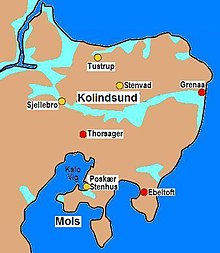Romle Stenovn
The Romle Stenovn ( German "Steinofen von Romle" ) is a round dysser from the Neolithic Age . The dolmen was built between 3,500 and 2,800 BC. Built by the carriers of the funnel beaker culture (TBK) at the northern end of a rocky outcrop in Kolind , on the south side of the now silted Kolindsund in Djursland in East Jutland, in Denmark .
description
The round dolmen has a massive capstone that rests on a number of supporting stones that barely protrude from the round hill, which is still halfway up, which indicates a polygonal dolmen . The hill from which no curbs have survived may originally have covered the capstone. The chamber appears to have had a corridor to the east , as indicated by four relocated stones.
There are several bowls on the capstone , which presumably date from the Bronze Age .
No finds are known of the unexcavated burial mound.
In the church of Kolind there is the runestone DR 108, which is the only Danish Gardarike runestone that reports a death "in the east".
See also
literature
- Peter Vilhelm Glob: Ancient Monuments of Denmark , Neumünster 1968
- Jakob Vedsted: Fortidsminder og Kulturlandskab. En kildekritisk analysis af tragtbaegerkulturens found material from Norddjursland. Forlaget Skippershoved, Ebeltoft 1986, ISBN 87-981329-5-4 .
Individual evidence
- ↑ Runddysse is the common denomination in Denmark for dolmens that are located in a round hill. In contrast, dolmens lying in a rectangular mound bed are called long dolmens
Web links
Coordinates: 56 ° 21 ′ 18.1 ″ N , 10 ° 34 ′ 30.6 ″ E

